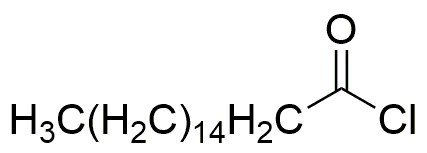Heptadecanoyl chloride is widely utilized in research focused on:
- Synthesis of Fatty Acid Derivatives: This compound serves as a key reagent in the synthesis of various fatty acid derivatives, which are important in the production of surfactants and emulsifiers used in cosmetics and personal care products.
- Pharmaceutical Applications: It is used in the development of pharmaceutical compounds, particularly in the synthesis of lipid-based drug delivery systems that enhance the bioavailability of poorly soluble drugs.
- Polymer Chemistry: Heptadecanoyl chloride is employed in the preparation of polyamide and polyester materials, which are utilized in textiles and packaging, offering improved durability and performance.
- Bioconjugation Techniques: This chemical is valuable in bioconjugation processes, allowing researchers to attach biomolecules to surfaces or other molecules, which is crucial for developing biosensors and diagnostic tools.
- Research in Lipid Chemistry: It plays a significant role in lipid chemistry research, helping scientists understand lipid metabolism and its implications in health and disease, which can lead to advancements in nutritional science and therapeutic strategies.
General Information
Properties
Safety and Regulations
Applications
Heptadecanoyl chloride is widely utilized in research focused on:
- Synthesis of Fatty Acid Derivatives: This compound serves as a key reagent in the synthesis of various fatty acid derivatives, which are important in the production of surfactants and emulsifiers used in cosmetics and personal care products.
- Pharmaceutical Applications: It is used in the development of pharmaceutical compounds, particularly in the synthesis of lipid-based drug delivery systems that enhance the bioavailability of poorly soluble drugs.
- Polymer Chemistry: Heptadecanoyl chloride is employed in the preparation of polyamide and polyester materials, which are utilized in textiles and packaging, offering improved durability and performance.
- Bioconjugation Techniques: This chemical is valuable in bioconjugation processes, allowing researchers to attach biomolecules to surfaces or other molecules, which is crucial for developing biosensors and diagnostic tools.
- Research in Lipid Chemistry: It plays a significant role in lipid chemistry research, helping scientists understand lipid metabolism and its implications in health and disease, which can lead to advancements in nutritional science and therapeutic strategies.
Documents
Safety Data Sheets (SDS)
The SDS provides comprehensive safety information on handling, storage, and disposal of the product.
Product Specification (PS)
The PS provides a comprehensive breakdown of the product’s properties, including chemical composition, physical state, purity, and storage requirements. It also details acceptable quality ranges and the product's intended applications.
Certificates of Analysis (COA)
Search for Certificates of Analysis (COA) by entering the products Lot Number. Lot and Batch Numbers can be found on a product’s label following the words ‘Lot’ or ‘Batch’.
*Catalog Number
*Lot Number
Certificates Of Origin (COO)
This COO confirms the country where the product was manufactured, and also details the materials and components used in it and whether it is derived from natural, synthetic, or other specific sources. This certificate may be required for customs, trade, and regulatory compliance.
*Catalog Number
*Lot Number
Safety Data Sheets (SDS)
The SDS provides comprehensive safety information on handling, storage, and disposal of the product.
DownloadProduct Specification (PS)
The PS provides a comprehensive breakdown of the product’s properties, including chemical composition, physical state, purity, and storage requirements. It also details acceptable quality ranges and the product's intended applications.
DownloadCertificates of Analysis (COA)
Search for Certificates of Analysis (COA) by entering the products Lot Number. Lot and Batch Numbers can be found on a product’s label following the words ‘Lot’ or ‘Batch’.
*Catalog Number
*Lot Number
Certificates Of Origin (COO)
This COO confirms the country where the product was manufactured, and also details the materials and components used in it and whether it is derived from natural, synthetic, or other specific sources. This certificate may be required for customs, trade, and regulatory compliance.

